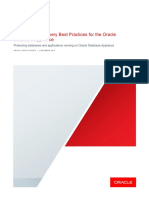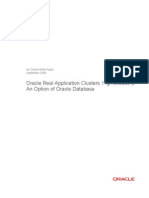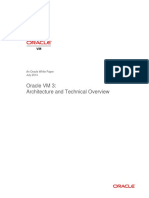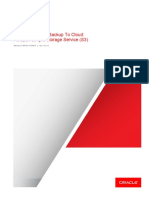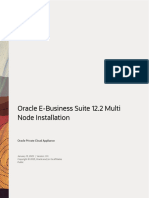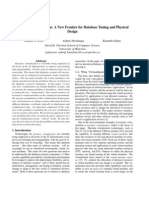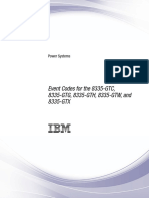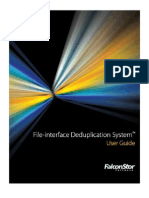Oracle Private Cloud Appliance Backup Guide: Oracle White Paper - July 2019
Oracle Private Cloud Appliance Backup Guide: Oracle White Paper - July 2019
Uploaded by
Mohamed Maher AlghareebCopyright:
Available Formats
Oracle Private Cloud Appliance Backup Guide: Oracle White Paper - July 2019
Oracle Private Cloud Appliance Backup Guide: Oracle White Paper - July 2019
Uploaded by
Mohamed Maher AlghareebOriginal Title
Copyright
Available Formats
Share this document
Did you find this document useful?
Is this content inappropriate?
Copyright:
Available Formats
Oracle Private Cloud Appliance Backup Guide: Oracle White Paper - July 2019
Oracle Private Cloud Appliance Backup Guide: Oracle White Paper - July 2019
Uploaded by
Mohamed Maher AlghareebCopyright:
Available Formats
Oracle Private Cloud Appliance Backup Guide
ORACLE WHITE PAPER | JULY 2019
Introduction 1
Scope 1
Private Cloud Appliance Availability Concepts 1
Architecture and Components 2
Management Nodes 2
Compute Nodes 2
Network Infrastructure 3
Storage 4
Data Backup Categories 5
Internal Backup 6
Exporting Internal Backup Data to External Storage 7
Oracle VM Repositories and Backup Data 7
Repository Locations and Types 7
Storage Array Snapshot, cloning, and replication 11
Conclusion and further reading 11
ORACLE PRIVATE CLOUD APPLIANCE BACKUP GUIDE
Introduction
The Oracle Private Cloud Appliance (PCA) is an integrated hardware and software system designed to
reduce infrastructure complexity and deployment time for virtualized workloads in private clouds. It is a
complete platform for a wide range of application types and workloads, with built-in compute, storage
and networking. PCA automatically discovers components and configures them to work with one
another, reducing design and administrative effort, eliminating potential errors, and speeding time to
application deployment. It enables virtualization life cycle management using Oracle VM.
This document reviews Private Cloud Appliance architecture, describes automated internal system
backups of software components, and describes how to backup data, including PCA system data,
Oracle VM repositories and database, and virtual machine contents.
Scope
This document covers backing up data on the Private Cloud Appliance (PCA). The Private Cloud Appliance software
stack consists of the Private Cloud Appliance Controller, Oracle VM Manager and their repository and data objects.
PCA system data is located on the built-in (internal) ZFS storage appliance. Virtual machine data also resides on the
ZFS appliance and on optional external storage. This document is intended for use with Private Cloud Appliance
2.3.1 and later. Starting in July 2019, this document contains content for the Oracle PCA X8 and PCA release 2.4.1,
which provides enhanced compute, storage and network features.
Because the Private Cloud Appliance is an engineered system and managed as a unit, infrastructure data restore
(as distinguished from user data in VMs) is restricted to specific use-cases. Oracle Support should be contacted to
help restore system infrastructure data. Virtual machine data generally resides in Oracle VM storage repositories
and is in most regards backed up the same way on PCA as on non-engineered systems running Oracle VM. PCA-
specific considerations are described below.
Private Cloud Appliance Availability Concepts
The Private Cloud Appliance (PCA) has redundant management, compute, network and storage components to
ensure that failure of any single component does not affect overall system availability. PCA takes automated internal
backups of key infrastructure data to capture configuration and system state. These measures protect against
individual hardware component failures and accidental deletion or data corruption. This document will discuss the
different types of data and how they are backed up.
Internal backups do not protect against catastrophic failures such as lost power or system damage, so this
document also discusses how to backup data to storage external to the PCA system. Taking regular backups is part
of standard operating procedures for all production systems.
The Private Cloud Appliance contains a ZFS storage appliance residing on the PCA internal networks. This ZFS
appliance serves as the PCA “system disk” and as the default location for Oracle VM data. Data must be copied
from the ZFS appliance using hosts that are on both datacenter and internal PCA networks. The recommended
method is to replicate ZFS shares to an external ZFS storage appliance using the ZFS appliance share replication
feature. Alternatively, data can be copied to external storage using a bastion host based on the PCA management
nodes, an appliance VM, or a compute node with a custom host network.
1 | ORACLE PRIVATE CLOUD APPLIANCE BACKUP GUIDE
Oracle recommends that critical systems be protected using disaster recovery (DR) practices and technologies. An
example of this is a PCA system located at a different site, with content kept up to date with changes made on the
primary system. That would provide standby capability in the event of failure of the primary system. Disaster
Recovery for Oracle VM 3, including PCA, is described in the whitepaper “Oracle VM 3: Implementing Oracle VM
DR Using Site Guard” at https://www.oracle.com/a/tech/docs/sn21305-siteguard-ovm-dr-whitepaper.pdf and in
MOS note “Oracle VM 3: Getting Started with Disaster Recovery (Doc ID 1959182.1)”.
Architecture and Components
This section summarizes the architecture of the Private Cloud Appliance. For further information, please consult the
Oracle Private Cloud Appliance Release 2.4 Administrator's Guide for PCA systems based on the PCA X8 rack, and
the Oracle Private Cloud Appliance Release 2.3 Administrator's Guide for PCA systems based on the PCA X5 rack
and earlier. Documentation is at https://www.oracle.com/technetwork/server-storage/private-cloud-
appliance/documentation/index.html
Management Nodes
The heart of each Private Cloud Appliance is a pair of dedicated management nodes, arranged in an active/standby
cluster for high availability. Both servers can run the same services and have equal access to the system
configuration, but one operates as the master while the other is in standby mode. The standby node automatically
takes over if a failure occurs. The master node runs the full set of services, in particular Oracle VM Manager, the
PCA Controller, the Dashboard, failover, and other system services. These services are briefly unavailable during a
failover. This does not affect Oracle VM Server or virtual machine operation on the compute nodes, which continue
without interruption. The standby node runs a subset of services until it is promoted to the master role, at which time
the previous master node assumes the standby role..
Management nodes boot off local disks, arranged in RAID pairs for media resiliency, and access all system-wide
data stored on the built-in Oracle ZFS Storage Appliance. The master role is determined via OCFS2 Distributed
Lock Management on an iSCSI LUN which both management nodes share on the Oracle ZFS Storage Appliance.
The management node that acquires the lock assumes the master role.
Management nodes access the Private Cloud Appliance internal networks using pre-defined network addresses,
and access customer datacenter networks via addresses defined by the system administrator at install time. Each
management node has an IP address on the customer datacenter network, and a virtual IP (VIP) address is
assigned to the node currently owning the master role. This provides external connectivity between management
nodes and the customer network for browser access to the Private Cloud Appliance Dashboard and Oracle VM
Manager, and for data transfer. The process for assigning these addresses is described in the Installation Guide.
Compute Nodes
Oracle Server X8-2, X7-2, X6-2, X5-2, X4-2 or X3-2 compute nodes in the Private Cloud Appliance constitute the
virtualization platform. The specific server type depends on which generation PCA this is. Compute nodes run
Oracle VM Server and provide processing power and memory capacity for virtual machines under Oracle VM
Manager's control.
An automated provisioning process orchestrated by the active management node configures compute nodes into
the Oracle VM environment. Private Cloud Appliance software installs Oracle VM Server software on each compute
node, defines their network configurations, and places all compute nodes into an Oracle VM server pool. Starting
2 | ORACLE PRIVATE CLOUD APPLIANCE BACKUP GUIDE
with PCA 2.2, administrators can define “tenant groups”, which isolate compute and storage resources in separate
Oracle VM server pools that can be assigned to different customers.
Each compute node has local storage to host the Oracle VM Server boot environment. Local disk capacity can
optionally be used as Oracle VM repositories for virtual machines running exclusively on that compute node, and
can be used for applications that do not require being able to run on another compute node. This is not a typical use
case, and virtual disks typically reside in shared repositories as described in the section on storage, below.
Network Infrastructure
The Private Cloud Appliance relies on “wire once” Software Defined Networking (SDN) that permits multiple isolated
virtual networks to be created on the same physical network hardware components. The appliance uses redundant
physical network hardware components, pre-cabled at the factory, to help ensure continuity of service in case a
failure should occur.
The PCA uses private, “internal” networks that are not exposed to the customer’s datacenter network. This provides
isolation, security, and the ability to use pre-defined IP address ranges for each networked component without
conflict with existing datacenter network addresses. Internal networks are used for the appliance management,
storage access, and inter-VM communication. Every PCA rack component has a predefined IP address, and Oracle
storage, management and compute nodes have a second IP address for Oracle Integrated Lights Out Manager
(ILOM) connectivity.
The Private Cloud Appliance rack also provides external network access for connectivity to a datacenter’s networks.
The PCA is connected to the datacenter network via a pair of next-level switches, also referred to TOR (top of rack)
switches. This provides resiliency against a single point of failure. Software Defined Networks (SDN connect virtual
machines and bare metal servers to networks, storage and other virtual machines, maintaining the traffic separation
traditionally provided by hard-wired connections and exceeding their performance.
Compute nodes connect to the internal networks and to the customer datacenter networks. Oracle VM Server on
each compute node communicates over Private Cloud Appliance internal networks for management, storage,
heartbeat and live migration. By default, compute nodes do not have IP addresses on the customer datacenter
network, which increases their isolation and reduces attack surface. Custom networks can be created to give
compute nodes IP addresses on the customer network, for additional bandwidth, traffic separation, and to present
Ethernet-based storage to each compute node,.
Guest virtual machines access the customer datacenter network using an Oracle VM network named
“default_external” on PCA 2.4.1, and "vm_public_vlan" on previous releases. An additional virtual machine
network named “default_internal” on PCA 2.4.1 and "vm_private" on previous releases is internal to the
Private Cloud Appliance and used for private, high-performance, low-latency network traffic between virtual
machines. Both internal and external networks can be used with VLANs for network separation to isolate VMs from
one another. These networks are pre-defined in Oracle VM Manager with the "Virtual Machine" function (also called
a "channel") - indicating they are used for guest VM TCP/IP traffic and not cluster management, storage, or live
migration. This ensures that guest VMs do not see infrastructure network traffic.
The preceding networks are the ones administers usually work with, for creating connectivity for virtual machines.
Additional SDNs, based on the version of Private Cloud Appliance, are automatically configured during the
initialization process. During the installation process, the administrator assigns three reserved IP addresses from the
data center (public) network range to the management node cluster of the Private Cloud Appliance: one for each
management node, plus a Virtual IP owned by whichever management node is currently the master. The Virtual IP
3 | ORACLE PRIVATE CLOUD APPLIANCE BACKUP GUIDE
is used to connect to the master management node's web server, which hosts both the Private Cloud Appliance
Dashboard and the Oracle VM Manager web interface.
Configuration data for these essential network infrastructure components is backed up by the PCA's automatic
internal backup process as described in the section "Private Cloud Appliance Internal Backup".
Storage
The PCA comes with built-in storage, using the Oracle ZFS Storage Appliance. This “internal ZFS” contains PCA
system data, and serves as a 'system disk' for the entire PCA. It also contains a default Oracle VM repository to
store VM disk images and templates. Backing up the internal PCA repository is similar to backing up any Oracle VM
repository. The internal ZFS is on PCA private networks and not exposed to the customer’s Ethernet network. Steps
to back it up to external storage are described below.
PCA supports compute node connection to external storage for Oracle VM repositories and LUNs presented to
virtual machines. Starting with PCA 2.4.1, the internal ZFS is a high-performance, high capacity storage array that
can be used for demanding applications. In PCA versions prior to X8-2, the internal ZFS was a small capacity device
suitable for moderate performance and capacity requirements and primarily functions as the PCA system disk.
External storage was recommended for scale and performance. External storage can be used with PCA 2.4.1, but
PCA now provides more scalability. Oracle staff can help size storage to meet application requirements.
Guest virtual machines generally use virtual disks from a repository. VMs can also use presented directly to the VM
for optimized performance. These are described as “physical disks” in Oracle VM documentation, and appear to the
VM as local disks. Virtual machines can additionally connect to a datacenter’s networked storage based on Object,
NFS, CIFS or iSCSI protocols. This is done under virtual machine operating system control just as with physical
server environments, and is transparent to PCA or Oracle VM operation..
PCA ZFS Storage
Compute and management nodes boot off their own local disks and access system-wide data stored on the ZFS
appliance. The ZFS appliance provides storage space for the Private Cloud Appliance software, including the Oracle
VM Manager, and OS boot images for network-installing compute nodes. It also contains backup copies of the
configuration data for every system component. Compute and management nodes access the ZFS appliance via
the storage network described previously. This network is private to the appliance, and provides high performance,
isolation, and security.
The Oracle ZFS Storage Appliance contains two clustered storage heads for redundancy, so data remains available
even if a head fails. Data is arranged in a redundant configuration that is optimized for hardware fault tolerance,
detects and corrects data errors, and can tolerate media failures without data loss. Cache and log SSD devices are
used to improve performance. This provides a balance between performance, available space, and redundancy for
data protection.
The storage pool contains projects named OVCA (from the original product name) and OVM, with predefined iSCSI
LUNs and NFS file systems. The OVCA project contains all LUNs and file systems used by the PCA software. The
most significant of these are:
» LUNs:
» Locks - used exclusively for cluster locking of the two management nodes. The two nodes contend for the
lock to determine which assumes the master role.
4 | ORACLE PRIVATE CLOUD APPLIANCE BACKUP GUIDE
» File systems:
» MGMT_ROOT - used for storage of all files specific to the Private Cloud Appliance, and mounted via NFS on
each management node at /nfs/shared_storage. Its contents and backup are described below.
The OVM project contains all LUNs and file systems used by Oracle VM. The iSCSI LUNs are automatically
deployed for use by Oracle VM, and the file systems are made available for customers preferring NFS. The default
LUNs and file systems are shown below:
» LUNs:
» iscsi_repository1 – the LUN for the default Oracle VM storage repository Rack1-Repository
» iscsi_serverpool1 – the LUN for the server pool file system used for the Oracle VM clustered server
pool Rack1_ServerPool. Additional LUNs are defined automatically when PCA tenant groups are created.
Each tenant group consists of a server pool and related pool file system.
» File systems:
» nfs_repository1 - available to be used as an additional Oracle VM storage repository in case NFS is
preferred over iSCSI.
» nfs_serverpool1 - available for a server pool file system for an Oracle VM clustered server pool. In
practice unused since a pool file system is automatically allocated on an iSCSI LUN when a tenant group
is created.
Broadly speaking storage for the PCA falls into two categories: storage used for Oracle VM repositories and pdisks,
(often referred to as ‘inside’, ‘back end, or ‘repository’’ storage) presented to Oracle VM Server on each compute
node, and storage presented to VMs as shared storage (often referred to as ‘outside’, ‘front-end’, or ‘shared’
storage). As mentioned above, in the PCA X5-2 and earlier, Oracle recommends using external storage to increase
performance, capacity and management.
Repository storage can be a ZFS storage appliance connected by InfiniBand or Ethernet, or other storage
connected by Fibre Channel via a Fibre Channel switch, or NFS and iSCSI over a host network. The Private Cloud
Appliance documentation describes how to attach and configure external storage. This storage is generally not
made available directly to the VMs themselves as a segregation and security measure.
Shared storage is presented to VMs through their respective vNIC (virtual NIC) interfaces and must be located on a
network accessible to the VMs. Virtual Machines can use the 10Gb Ethernet datacenter network (or in the case of
X8-2 and the internal ZFS, an internal network) to connect to existing networked storage. Virtual machines can use
Object, NFS, CIFS or iSCSI protocols just as if they were running on physical servers, without requiring
administrative support from PCA or Oracle VM. Backup of external storage devices is identical to backup on non-
PCA Oracle VM deployments.
Data Backup Categories
Data components on the Private Cloud Appliance have different backup and restore requirements, depending on
their purpose, where they reside, and how they are created. For the highest level of data integrity, Oracle
recommends using application aware backup technologies consistent with Oracle Maximum Availability Architecture
(MAA), just as on physical servers. This leverages well-established backup and recovery practices, enables
transactional awareness, provides data integrity superior to “crash consistency” and is more efficient than relying
exclusively on virtual disk image backups.
» Private Cloud Appliance system data containing system state and configuration for PCA itself. This data is backed
up internally from PCA and Oracle VM components (including Oracle VM Manager MySQL backup and ZFS
Storage Appliance configuration) to a directory on the internal ZFS appliance. This protects from accidental
5 | ORACLE PRIVATE CLOUD APPLIANCE BACKUP GUIDE
removal or corruption of the backed up components, but not loss of the ZFSSA. A few simple commands can
copy data to external storage (illustrated below). It is expected that Oracle Support would assist in any restore
operation to ensure the Private Cloud Appliance is in a consistent state.
» Compute nodes run Oracle VM Server and have local per-node storage presented to Oracle VM as local storage
repositories. Local repositories are not accessible by other servers and are not backed up. Oracle VM Serve7r
system data is recreated when a node is re-provisioned so backing it up is not required. However, local storage
repositories contents are not preserved if the node is re-provisioned, and should be copied using documented
Oracle VM repository backup procedures, or by moving a VM from the local repository to a different repository in
the PCA.
» Virtual machine data resides in repositories that contain virtual machine metadata, virtual disk image files, and
pre-built virtual machines in the form of assemblies and templates. It may also include LUNs presented directly to
virtual machines (referred to as “physical disks” in Oracle VM documentation). This data can be backed up and
restored by the customer using documented Oracle VM recovery practices. Guest virtual machines are on the
datacenter network, and can be backed up by scripts or backup products exactly as if they were physical
machines using existing backup methods from Oracle and third party vendors. This can be used in addition to
backing up entire virtual disk images for MAA-consistent data integrity.
» The Oracle ZFS Storage Appliance is the storage location for the above data categories, except for local
repositories on each compute node and the optional external storage. Backing up ZFS storage appliance contents
is the primary mechanism for backing up PCA.
Internal Backup
The configuration data of all components within Private Cloud Appliance is automatically backed up and stored on
the Oracle ZFS Storage Appliance in compressed archives. Backup archives are named with a timestamp based on
when the backup is run to make it easy to identify backup dates. A crontab entry on the active management node
starts a backup job every day at 9am and 9pm.The primary purpose of this backup data is to be restored in case of
emergency, in coordination with Oracle Support.
Backups are stored on the MGMT_ROOT filesystem on the Oracle ZFS Storage Appliance and are accessible on
each management node at /nfs/shared_storage/backups. The backup process creates a compressed tar file
named with the timestamp for the current backup job. For example, the backup taken at 9am on September 8, 2015,
is named "2015_09_08-09.00.01.tar.bz2". The compressed tar file contains several subdirectories, including:
» ovca: contains the configuration information relevant to the deployment of the management nodes such as the
password wallet, the network configuration of the management nodes, configuration databases for the Private
Cloud Appliance services, and DHCP configuration.
» ovmm: contains the most recent backup of the Oracle VM Manager database, the source data files for the current
database, and the UUID information for the Oracle VM Manager installation. The backup process for the Oracle
VM Manager database is handled automatically from within Oracle VM Manager and is described in detail in the
Oracle VM Installation and Upgrade Guide in the section Oracle VM Manager MySQL Backup and Restore
» zfssa: contains all of the configuration information for the Oracle ZFS Storage Appliance as described in section
Configuration Backup in the Sun ZFS Storage Appliance Customer Service Manual. Configuration data can be
imported into the ZFS Storage Appliance and then restored to active state.
Other directories are in the archive files depending on the product release. The backup process collects data for
each component in the appliance and stores it in a way that makes it possible to restore that component to operation
in the case of failure. Note that there is no automated process to remove old backup tar files from
/nfs/shared_storage/backups, so this directory will consume increased disk space over time, but still small
relative to the ZFS appliance capacity. Customers should remove old files consistent with their retention policies.
6 | ORACLE PRIVATE CLOUD APPLIANCE BACKUP GUIDE
Restore should be undertaken in conjunction with Oracle Support to ensure proper procedural steps are used. The
exception to this rule is the ovmm subdirectory, which can be used to restore an Oracle VM Manager database using
documented Oracle VM methods.
Exporting Internal Backup Data to External Storage
The previous section describes data stored on the PCA’s ZFS Storage Appliance. This should be copied to external
storage on a regular basis to handle a catastrophic loss that would make the storage appliance unavailable.
Backup data tar files can easily be copied from the management node with scp or rsync commands. For
example, commands like the two below can be issued on an Oracle Linux or Oracle Solaris host on the customer
network (assuming the public hostname for the management node is as shown below, and adjusting destination
names):
# scp root@mn1.example.com:/nfs/shared_storage/backups/2015_09_08*bz2 .
# rsync –azP root@mn1.example.com:/nfs/shared_storage/backups/ /home/pcabackups
This first command copies the internal backup created on September 8, 2015 (assuming the datacenter network
hostname of the management node); the second command synchronizes the entire backup directory. Backups can
also be initiated from the node by issuing a command like:
[root@ovcamn05r1 ~]# scp /nfs/shared_storage/backups/* backupuser@backuphost:
Alternatively, the management node could mount an NFS server on the datacenter network and simply copy the
directory tree under /nfs/shared_storage/backups/ onto it.
Another method is to add the Virtual Machine role to the management network defined in Oracle VM Manager, and
create an appliance virtual machine with a virtual network interface on that network. This would let the appliance VM
access the internal backup on the ZFS Storage Appliance and the Oracle VM repositories, while also having
network access to the public datacenter network. This is described in MOS note “How to Create Service Virtual
Machines on the Private Cloud Appliance by using Internal Networks (Doc ID 2017593.1)”. The virtual machine
would use methods similar to those described above, and would have the advantage of letting the customer choose
their own management software, network MTU, and retaining customization over a PCA upgrade. Customers should
evaluate the security and isolation implications of using a specially configured VM that has access to internal PCA
data, and the possibility of accidentally providing virtual NICs on the management network to other VMs, versus
using the management node for backup functions. Such a VM can enhance security compared to using the
management node by being protected with firewalls and using the installation’s authentication standards.
Oracle VM Repositories and Backup Data
The preceding section discussed infrastructure configuration data, including the Oracle VM Manager's MySQL
backup. It is also important to backup Oracle VM Manager repositories, which contain virtual disks, templates,
assemblies, and virtual machine descriptor files. Successful recovery of any Oracle VM environment requires
backup and recovery of repositories. Most practices for backing up Oracle VM inside the Private Cloud Appliance
are the same as in the general Oracle VM environment. For a full discussion of Oracle VM backup and recovery,
please read the Oracle VM User's Guide and the Oracle VM 3: Backup and Recovery Best Practices Guide.
Repository Locations and Types
7 | ORACLE PRIVATE CLOUD APPLIANCE BACKUP GUIDE
The Private Cloud Appliance provisions an Oracle VM repository per PCA rack, named Rack1-Repository. The
repository is available to all compute nodes on the PCA rack. This is the default internal ZFS repository for virtual
disks, assemblies, ISO images, templates and virtual machine descriptions for VMs. Additional repositories would be
created if tenant groups are deployed.
Contents on the internal ZFS appliance can be copied to external backup storage. In PCA prior to PCA 2.4, the
internal ZFS contents can be replicated using the replication feature of the ZFS appliance to an InfiniBand-
connected external ZFS. In PCA 2.4.1 and later, network connectivity can be added to the ZFS appliance to permit
ZFS replication to an external Ethernet-connected ZFS appliance, even one potentially in a different geographical
location. The replication feature, normally an additional license cost in the ZFS appliance is included for the ZFS
internal to the PCA.
PCA can be connected to external storage, which permits using the customer’s existing storage infrastructure and
standard backup methodology. Backing up repository data on external storage is identical to backing up
Oracle VM repositories in non-PCA environments.
The PCA system also creates local disk repositories on the internal disks of each compute node when the node is
provisioned. This extends the disk capacity of the system by making use of approximately 800GB to 1TB of disk
space remaining on each compute node's disks after Oracle VM Server is installed. The actual amount depends on
whether the compute node is an X3-2 or a later model. As more compute nodes are installed, more disk capacity
becomes available. Each local repository is named ovcacnXXrY-localfsrepo, where ovcacnXXrN is the name
of the compute node (XX is the rack unit position, and N is the rack number).
Local repositories can only be used by virtual machines on the one compute node they are attached to, and become
unavailable if the compute node fails. This potential single point of failure should be considered when deciding
where to store virtual machine data. Virtual machine contents that can be recreated can be usefully kept there,
improving the overall storage capacity of the PCA environment. Migrating or cloning VMs on these repositories to
the internal ZFS will allow the clone or migrated image to be included with ZFS replication above.
Virtual Machine and Repository Data Backup
Data can be protected at the file, virtual disk and virtual machine, and repository levels. Oracle recommends that
application data on virtual disks be backed up on a file basis by the virtual machines when file level granularity and
transactional semantics are needed. This can be done using application software, command line utilities or
networked backup products just as on a bare metal physical system. This provides transaction and data integrity
and permits application control. For example, a virtual machine running Oracle Database can use RMAN to copy its
contents to an external backup destination. Virtual machines can also use third party backup vendor products to do
file-level incremental backups to backup servers.
Application-level backup within a virtual machine is ideal for transaction-level control, but is not a substitute for
backing up a VM’s complete virtual disk images. VM level “online backups” can be made by cloning a VM using the
Oracle VM Manager’s user interface or CLI. Oracle VM supports “thin clones” of running VMs whose disks are on
OCFS2 format iSCSI or fibre-channel LUNs repositories, which are used with PCA. Clones can be used as crash-
consistent VM snapshots. Data integrity is ensured by taking VM clones when the VMs are not running. This does
not provide protection against loss of a PCA system or a repository, but can protect against data corruption, or used
to back out an OS or application change in the VM.
Repositories should be backed up to protect against storage loss or corruption. They can be backed up using ZFS
share replication from one ZFS appliance to another, or by using block level replication features available with
various enterprise-grade storage arrays. When any external storage array is used for Oracle VM contents, data can
8 | ORACLE PRIVATE CLOUD APPLIANCE BACKUP GUIDE
be backed up using standard Oracle VM methods. Oracle recommends using ZFS replication to an external ZFS
appliance as the best method to back up storage repositories.
When ZFS replication is not available, internal ZFS appliance repository data can be backed up using procedures in
the Oracle VM User's Guide section “Enabling Storage Repository Back Ups”. This creates an NFS share that
exports a repository's contents. The mount is exported to a specified host from a compute node in the pool. A local
repository is exported from the compute node owning it, and the shared repository can be exported by any compute
node in the rack. The NFS share can be mounted on a bastion host, and virtual machine configured to the internal
network as described previously at MOS note 2017593.1, or the management node, which has network access to
the internet network available to the compute node, and to the customer's datacenter network. This can be done by
performing the following steps:
First, navigate in the Oracle VM Manager User Interface to the Servers and VMs tab. Under Server Pools,
expand Rack1-ServerPool to show the server names, and highlight one of the servers to select it. Then select
Repository Exports from the Perspective view in the management pane as shown in Figure 3.
Figure 3. Oracle VM Repository Exports view
Next, click on the icon to create a repository export, which opens the following dialog. Select the repository to
be exported, and the IP address or hostname of the host that will mount the NFS share. In this example, we use a
management node, since it has network access to the compute nodes and to the datacenter network; it could also
be a service virtual machine. Specify "ro,no_root_squash" to ensure a read-only mount that makes all of the
repository files visible, as shown in Figure 4.
9 | ORACLE PRIVATE CLOUD APPLIANCE BACKUP GUIDE
Figure 4. Create Repository Export
After filling in the dialog boxes, click OK. The user interface will show the name of the exported path, as shown in
Figure 5. This path can be cut-and-paste into a command line to issue an NFS mount.
Figure 5. Show Repository Export
Once mounted, the exported file system can be browsed and copied to an external location. Log into a management
node, mount the share, and copy its contents to a network destination external to the PCA environment:
# mount 192.168.4.5:/OVS/Repositories/0004fb00000300006046c6c5fbcb91e9/ /mnt
# ls –l /mnt
drwx------ 3 root root 3896 Oct 6 04:27 Assemblies
drwx------ 2 root root 3896 Oct 5 04:28 ISOs
drwxr-xr-x 2 root root 3896 Oct 5 04:28 lost+found
drwx------ 3 root root 3896 Oct 6 05:53 Templates
drwx------ 2 root root 3896 Oct 8 02:37 VirtualDisks
drwx------ 5 root root 3896 Oct 8 02:37 VirtualMachines
# scp -rp /mnt/* backupuser@backuphost:
10 | ORACLE PRIVATE CLOUD APPLIANCE BACKUP GUIDE
This provides a complete backup of the Oracle VM repositories. This procedure uses one of the management nodes
as a bastion host to access the repository and copy it to external storage, but the same method could be used with a
service virtual machine, as discussed previously. This process is used with standard Oracle VM deployments, and
can be managed using documented Oracle VM procedures. PCA systems using software level 2.2.1 or later can
create a host network providing network connectivity to the compute nodes, and then directly copy repository
contents to external storage without needing an NFS export or bastion host.
Storage Array Snapshot, cloning, and replication
The preceding methods are host-based and “Oracle VM centric”, using Oracle VM configuration administrative
interfaces to expose important data and create backups. A very effective approach is to use the capabilities
available in many storage arrays to provide data protection. This is largely out of the scope of this white paper, as
details depend on the different storage array features. This applies to Oracle VM in general rather than being
specific to the Private Cloud Appliance, and there are many attractive options.
For example, LUNs or NFS shares can be cloned to provide copies to use for fallback, or to be replicated between
different storage devices. Data can be replicated between the internal ZFS appliance and an external ZFS, and then
backed up to a remote ZFS appliance or to tape. Similar replication can be done with Fibre Channel devices. This
could be used for local backup or for disaster recovery architectures. Combined with application and VM level
backup under Oracle VM, this can be a robust approach for data protection.
Conclusion and further reading
This whitepaper reviews the architecture of the Private Cloud Appliance, with a special focus on data elements in it
that need to be backed up to protect them against outage. PCA creates internal backups of key data components to
protect them against accidental erasure or corruption. Additional steps can be used to copy important data to
external storage, providing insulation against catastrophic failures.
The first source for further reading is the PCA product page http://www.oracle.com/technetwork/server-
storage/private-cloud-appliance/overview/index.html This has links to the official PCA documentation and PCA
whitepapers, including the guide to expanding PCA with ZFS storage at https://www.oracle.com/technetwork/server-
storage/private-cloud-appliance/expanding-oracle-private-cloud-4305175.pdf
The reader is encouraged to review the Oracle VM documentation and whitepapers as most of their content applies
to the Private Cloud Appliance. The page http://www.oracle.com/technetwork/server-storage/vm/overview/index-
160875.html links to these papers, such as http://www.oracle.com/technetwork/server-storage/vm/ovm3-disaster-
recovery-1872591.pdf The reader is also encouraged to review MOS note “Oracle VM 3: Getting Started with
Disaster Recovery (Doc ID 1959182.1)”..
11 | ORACLE PRIVATE CLOUD APPLIANCE BACKUP GUIDE
Oracle Corporation, World Headquarters Worldwide Inquiries
500 Oracle Parkway Phone: +1.650.506.7000
Redwood Shores, CA 94065, USA Fax: +1.650.506.7200
CONNECT W ITH US
blogs.oracle.com/oracle Copyright © 2019, Oracle and/or its affiliates. All rights reserved. This document is provided for information purposes only, and the
contents hereof are subject to change without notice. This document is not warranted to be error-free, nor subject to any other
warranties or conditions, whether expressed orally or implied in law, including implied warranties and conditions of merchantability or
facebook.com/oracle fitness for a particular purpose. We specifically disclaim any liability with respect to this document, and no contractual obligations are
formed either directly or indirectly by this document. This document may not be reproduced or transmitted in any form or by any means,
twitter.com/oracle electronic or mechanical, for any purpose, without our prior written permission.
Oracle and Java are registered trademarks of Oracle and/or its affiliates. Other names may be trademarks of their respective owners.
oracle.com
Intel and Intel Xeon are trademarks or registered trademarks of Intel Corporation. All SPARC trademarks are used under license and
are trademarks or registered trademarks of SPARC International, Inc. AMD, Opteron, the AMD logo, and the AMD Opteron logo are
trademarks or registered trademarks of Advanced Micro Devices. UNIX is a registered trademark of The Open Group. 0719
Oracle Private Cloud Appliance Backup Guide
July 2019
Author: Jeff Savit
Contributing author: Bob Bownes
You might also like
- Exadata Training Full SatyaDocument191 pagesExadata Training Full SatyaGanesh Ganeshan80% (5)
- TRN4078 Application High Availability Best Practices and New Features Public - 1540591572071001fpwiDocument46 pagesTRN4078 Application High Availability Best Practices and New Features Public - 1540591572071001fpwiMohamed Maher AlghareebNo ratings yet
- Exacs ArchDocument13 pagesExacs Archmohitkr.jindalNo ratings yet
- Vmsrvrsparc Reliability 163931Document29 pagesVmsrvrsparc Reliability 163931ภิญโญ อุดคณฑีNo ratings yet
- ODA - Backup and Recovery Best PracticesDocument40 pagesODA - Backup and Recovery Best PracticesEva EspositoNo ratings yet
- Backup and Recovery Best Practices For The Oracle Database ApplianceDocument28 pagesBackup and Recovery Best Practices For The Oracle Database ApplianceelshiharyNo ratings yet
- A11 020 Rac Clusters Ldoms 439778Document47 pagesA11 020 Rac Clusters Ldoms 439778tan tranNo ratings yet
- Virtualizing Oracle 11g r2 Rac Database On Oracle VM 3 0 Methods TipsDocument23 pagesVirtualizing Oracle 11g r2 Rac Database On Oracle VM 3 0 Methods TipsKamel KhelifiNo ratings yet
- En Pca 3 0 Patch 301Document30 pagesEn Pca 3 0 Patch 301mkunhNo ratings yet
- A Technical Overview of Oracle Supercluster: Oracle White Paper - January 2017Document23 pagesA Technical Overview of Oracle Supercluster: Oracle White Paper - January 2017राकेश कुमार सिंहNo ratings yet
- Oracle Virtual Compute Appliance X3-2Document6 pagesOracle Virtual Compute Appliance X3-2Johan LouwersNo ratings yet
- Oracle Vs Sybase PDFDocument31 pagesOracle Vs Sybase PDFinfombmNo ratings yet
- Practice Exam Oracle Cloud Database Services 2024 Professional CertificationDocument4 pagesPractice Exam Oracle Cloud Database Services 2024 Professional CertificationfatoldopercusiiNo ratings yet
- What Is Oracle Database ?: 2. Explain Oracle Grid Architecture?Document4 pagesWhat Is Oracle Database ?: 2. Explain Oracle Grid Architecture?karamdoNo ratings yet
- Oracle Database Appliance X9-2-HA: Fully Redundant Integrated SystemDocument8 pagesOracle Database Appliance X9-2-HA: Fully Redundant Integrated SystemTwins LeongNo ratings yet
- Instance: A Bare Metal or Virtual Machine (VM) Host Running in The Cloud. Oracle CloudDocument64 pagesInstance: A Bare Metal or Virtual Machine (VM) Host Running in The Cloud. Oracle CloudSm SaimumNo ratings yet
- Ds Imdb CacheDocument3 pagesDs Imdb CachesamydogNo ratings yet
- Fusion OCI Q&A_1Document2 pagesFusion OCI Q&A_1arunchary007No ratings yet
- Oracle Autonomous Database Notes PDFDocument5 pagesOracle Autonomous Database Notes PDFLeela devi0% (1)
- Oracle Autonomous Database NotesDocument5 pagesOracle Autonomous Database NotesLeela deviNo ratings yet
- Migration non-CDB 12c Database From On-Prem To ExaCCDocument20 pagesMigration non-CDB 12c Database From On-Prem To ExaCCTran Quoc DungNo ratings yet
- 11gR2 RAC-Install Workshop Day1Document33 pages11gR2 RAC-Install Workshop Day1Tomas E Carpio MilanoNo ratings yet
- Oracle Database Appliance X8-2S / X8-2MDocument5 pagesOracle Database Appliance X8-2S / X8-2MOliveira RubensNo ratings yet
- Oracle Database Appliance X8-2-HA: Fully Redundant Integrated SystemDocument6 pagesOracle Database Appliance X8-2-HA: Fully Redundant Integrated SystemOliveira RubensNo ratings yet
- Ovm Sparc Livemigration 1522412Document27 pagesOvm Sparc Livemigration 1522412Cesar MuterNo ratings yet
- Frequently Asked Questions Oracle Private Cloud ApplianceDocument6 pagesFrequently Asked Questions Oracle Private Cloud ApplianceMohamed Maher AlghareebNo ratings yet
- Dell Storage Best Practices For Oracle VM (CML1118)Document61 pagesDell Storage Best Practices For Oracle VM (CML1118)rambabuNo ratings yet
- Oracle Real Application Clusters (RAC) 12c Best Practices: Markus Michalewicz Oracle Redwood Shores, CA, USADocument10 pagesOracle Real Application Clusters (RAC) 12c Best Practices: Markus Michalewicz Oracle Redwood Shores, CA, USAJorge UlloaNo ratings yet
- Oracle Data Guard - Concepts and AdministrationDocument61 pagesOracle Data Guard - Concepts and Administrationoliveira.aderlanNo ratings yet
- Implementing Root Domains With Oracle VM Server For SPARC: An Oracle White Paper February 2013Document22 pagesImplementing Root Domains With Oracle VM Server For SPARC: An Oracle White Paper February 2013Kishore ThakurNo ratings yet
- Oracle RAC Interview Questions (1)Document14 pagesOracle RAC Interview Questions (1)shraddhadhok13No ratings yet
- Cisco IT Case Study Oracle On VM On UCSDocument9 pagesCisco IT Case Study Oracle On VM On UCSCisco ITNo ratings yet
- MAA Goldengate Classic RacDocument35 pagesMAA Goldengate Classic RacvasantnNo ratings yet
- What Is RACDocument9 pagesWhat Is RACGitika Arora DhingraNo ratings yet
- Using Oracle Database Backup Service PDFDocument41 pagesUsing Oracle Database Backup Service PDFAlphani BaziroNo ratings yet
- Configuration WorksheetDocument30 pagesConfiguration WorksheetSami DziriNo ratings yet
- Oda x8 2sm Datasheet 5730738Document5 pagesOda x8 2sm Datasheet 5730738cedric agokeng kitioNo ratings yet
- Book Oracle RACDocument124 pagesBook Oracle RACKamal Kumar100% (1)
- Oracle Cluster Ware 11grel2 Owp 1 129843Document19 pagesOracle Cluster Ware 11grel2 Owp 1 129843db4dbaNo ratings yet
- Hybrid Data Guard in OCI - Exadata Cloud ServiceDocument18 pagesHybrid Data Guard in OCI - Exadata Cloud Serviceali01966No ratings yet
- Oracle Asm Emc TF-SRDF 02-06-0Document22 pagesOracle Asm Emc TF-SRDF 02-06-0Saeed MeethalNo ratings yet
- Oracle Real Application Clusters 11g Release 2Document15 pagesOracle Real Application Clusters 11g Release 2Fabio MescolloteNo ratings yet
- Load BalancingDocument7 pagesLoad BalancingParuchuri KiranNo ratings yet
- Ovm3 Arch Tech Overview 459307Document18 pagesOvm3 Arch Tech Overview 459307Peter KidiavaiNo ratings yet
- Oda x10 Ha DatasheetDocument8 pagesOda x10 Ha DatasheetSinh DangNo ratings yet
- Oracle WP Oda x9-2slDocument9 pagesOracle WP Oda x9-2slRick GamingNo ratings yet
- Enterprise Deployment - Failover Clustering With Laserfiche 8Document16 pagesEnterprise Deployment - Failover Clustering With Laserfiche 8Yohanna Monsalvez RojasNo ratings yet
- Oracle Database Backup To Cloud: Amazon Simple Storage Service (S3)Document11 pagesOracle Database Backup To Cloud: Amazon Simple Storage Service (S3)Kumar GummulaNo ratings yet
- RAC Presentation Oracle10gR2Document103 pagesRAC Presentation Oracle10gR2hemalrohaNo ratings yet
- Oracle+E-Business+Suite+12.2+Multi+Node+Installation_OraclePCADocument40 pagesOracle+E-Business+Suite+12.2+Multi+Node+Installation_OraclePCAasadnawazNo ratings yet
- Oracle Server X8-2: Product OverviewDocument6 pagesOracle Server X8-2: Product OverviewDurga Prasad MukhiaNo ratings yet
- Rac TWP Overview 5303704 PDFDocument13 pagesRac TWP Overview 5303704 PDFragin123100% (1)
- Oracle RAC Interview Questions - ComprehensiveDocument7 pagesOracle RAC Interview Questions - Comprehensivekaleem.prodbaNo ratings yet
- Oracle RAC Interview Questions - ComprehensiveDocument7 pagesOracle RAC Interview Questions - Comprehensivekaleem.prodbaNo ratings yet
- Backup Hyperv2012 Zfssa 3000283Document61 pagesBackup Hyperv2012 Zfssa 3000283Edgar Sadday Sanchez VeraNo ratings yet
- Pro Azure Administration and Automation: A Comprehensive Guide to Successful Cloud ManagementFrom EverandPro Azure Administration and Automation: A Comprehensive Guide to Successful Cloud ManagementNo ratings yet
- Oracle 10g/11g Data and Database Management Utilities: Master 12 must-use Oracle Database Utilities with this Oracle book and eBookFrom EverandOracle 10g/11g Data and Database Management Utilities: Master 12 must-use Oracle Database Utilities with this Oracle book and eBookNo ratings yet
- Getting Started with CockroachDB: A guide to using a modern, cloud-native, and distributed SQL database for your data-intensive appsFrom EverandGetting Started with CockroachDB: A guide to using a modern, cloud-native, and distributed SQL database for your data-intensive appsNo ratings yet
- Learn Azure Administration: Explore cloud administration concepts with networking, computing, storage, and identity managementFrom EverandLearn Azure Administration: Explore cloud administration concepts with networking, computing, storage, and identity managementNo ratings yet
- Linux device-mapper-udev-CRS-ASM - v3.6Document22 pagesLinux device-mapper-udev-CRS-ASM - v3.6Mohamed Maher AlghareebNo ratings yet
- Frequently Asked Questions Oracle Private Cloud ApplianceDocument6 pagesFrequently Asked Questions Oracle Private Cloud ApplianceMohamed Maher AlghareebNo ratings yet
- Automate VM Creation From Template and Assembly - Ansible - NewDocument10 pagesAutomate VM Creation From Template and Assembly - Ansible - NewMohamed Maher AlghareebNo ratings yet
- Automate Infrastructure Lifecycle Management On PCA Using AnsibleDocument31 pagesAutomate Infrastructure Lifecycle Management On PCA Using AnsibleMohamed Maher AlghareebNo ratings yet
- Oracle Database Configuration With Oracle ZFS Storage ApplianceDocument25 pagesOracle Database Configuration With Oracle ZFS Storage ApplianceMohamed Maher AlghareebNo ratings yet
- Best Practices For Database Consolidation: A Guide For Implementation Including MAA Reference ArchitecturesDocument42 pagesBest Practices For Database Consolidation: A Guide For Implementation Including MAA Reference ArchitecturesMohamed Maher AlghareebNo ratings yet
- Maa GG Microservices On Rac 5073545Document40 pagesMaa GG Microservices On Rac 5073545Mohamed Maher AlghareebNo ratings yet
- Allocating Cores, RAM, and Hard Disk Space For Your Barracuda Web Application Firewall VXDocument3 pagesAllocating Cores, RAM, and Hard Disk Space For Your Barracuda Web Application Firewall VXTenishan FernandoNo ratings yet
- ArcSight Product Brief LoggerDocument3 pagesArcSight Product Brief Loggernduc_181273No ratings yet
- Cisco ASA 5510, ASA 5520, ASA 5540, and ASA 5550 Hardware Installation GuideDocument70 pagesCisco ASA 5510, ASA 5520, ASA 5540, and ASA 5550 Hardware Installation Guideroben parsieNo ratings yet
- Database VirtualizationDocument7 pagesDatabase VirtualizationObayd ShakeNo ratings yet
- A10 DS 15100 en PDFDocument12 pagesA10 DS 15100 en PDForellana160No ratings yet
- VxRail Appliance - VxRail Hardware Upgrade Procedures-Compute Node ExpansionDocument34 pagesVxRail Appliance - VxRail Hardware Upgrade Procedures-Compute Node ExpansionFabrice MaillardNo ratings yet
- IBM Security QRadar Log ManagerxxxDocument4 pagesIBM Security QRadar Log Managerxxxahmad5335No ratings yet
- Oracle ZDLRA Hardware Installation & Software Configuration Online Assessment (2023)Document19 pagesOracle ZDLRA Hardware Installation & Software Configuration Online Assessment (2023)Ashis DasNo ratings yet
- Am Migration Guide 7.1 New ApplianceDocument202 pagesAm Migration Guide 7.1 New Appliancetute_primusNo ratings yet
- Cisco Prime Infrastructure Appliance Hardware Installation GuideDocument18 pagesCisco Prime Infrastructure Appliance Hardware Installation Guidefaisal juwailesNo ratings yet
- N207Document4 pagesN207alrabieNo ratings yet
- IJRAR1DBP006Document6 pagesIJRAR1DBP006bimal007pantNo ratings yet
- Infoblox Ddi DatasheetDocument5 pagesInfoblox Ddi DatasheetCse 2k17No ratings yet
- Vsphere Esxi Vcenter Server 60 Installation Setup GuideDocument272 pagesVsphere Esxi Vcenter Server 60 Installation Setup Guidecarlos5sevillaNo ratings yet
- Hivemanager NG Virtual Appliance: Aerohive's Next-Generation Network Management Solution For On-Premises DeploymentsDocument2 pagesHivemanager NG Virtual Appliance: Aerohive's Next-Generation Network Management Solution For On-Premises DeploymentszwillNo ratings yet
- Panorama AdminGuideDocument236 pagesPanorama AdminGuideQuốc Vũ DươngNo ratings yet
- CER-23-047-SoW For Aruba ClearPass Support and Maintenance14062023 V3Document7 pagesCER-23-047-SoW For Aruba ClearPass Support and Maintenance14062023 V3Unitec InternationalNo ratings yet
- Thales Esecurity Vormetric Data Security PlatformDocument20 pagesThales Esecurity Vormetric Data Security PlatformtomektrNo ratings yet
- Dell Emc Networker: Cloudboost 19.3 Integration GuideDocument54 pagesDell Emc Networker: Cloudboost 19.3 Integration Guideasma merzouguiNo ratings yet
- DNT20 - Rockwell Visualization Full OverviewDocument80 pagesDNT20 - Rockwell Visualization Full OverviewMauricio OliveiraNo ratings yet
- Cisco Prime 2.2 GuideDocument16 pagesCisco Prime 2.2 Guidemaverick2689No ratings yet
- Event Codes For The 8335-GTC, 8335-GTG, 8335-GTH, 8335-GTW, and 8335-GTXDocument52 pagesEvent Codes For The 8335-GTC, 8335-GTG, 8335-GTH, 8335-GTW, and 8335-GTXCristian BoneloNo ratings yet
- Riverbed Steelhead Family Granite SpecSheetDocument8 pagesRiverbed Steelhead Family Granite SpecSheetIfan NsNo ratings yet
- Quo Vadis SAP HANA - Erwartungen Und Ausblick: Jürgen Karnstädt HP SAP Competence Center Walldorf Mai 2013Document26 pagesQuo Vadis SAP HANA - Erwartungen Und Ausblick: Jürgen Karnstädt HP SAP Competence Center Walldorf Mai 2013abidouNo ratings yet
- Falcons Tor FDS User GuideDocument117 pagesFalcons Tor FDS User GuideDavid FahrNo ratings yet
- DataSheet - Cisco Adaptive Security Virtual Appliance (ASAv)Document9 pagesDataSheet - Cisco Adaptive Security Virtual Appliance (ASAv)robidey08No ratings yet
- Vista Manager Network Appliance: Network Automation, Monitoring and ManagementDocument7 pagesVista Manager Network Appliance: Network Automation, Monitoring and ManagementLãng TửNo ratings yet
- SZ 5.2.2 Patch1 ReleaseNotes RevA 2021128Document23 pagesSZ 5.2.2 Patch1 ReleaseNotes RevA 2021128Marco MarcoNo ratings yet
- IBM Qradar 7.3.2 Instalation GuideDocument72 pagesIBM Qradar 7.3.2 Instalation Guide1991gabolopezNo ratings yet
- NetBackup 52xx Admin Guide 25Document242 pagesNetBackup 52xx Admin Guide 25acidlikeboy100% (1)





